T/617/1213 Finance: Sources of Finance for Businesses Report
VerifiedAdded on 2021/02/05
|22
|8076
|154
Report
AI Summary
This report delves into the multifaceted world of finance for businesses, covering the understanding of various funding sources, evaluating their costs and benefits, and analyzing the strategic implications of choosing different options. It begins by classifying sources into internal (such as owner's investment, retained earnings, and asset sales) and external (including equity shares, loans, and venture capital), further breaking down external sources into short-term, medium-term, and long-term categories. The report then evaluates the advantages and disadvantages of each source, such as the control and cost-effectiveness of internal financing versus the growth potential of external funding. A case study of Deliveroo illustrates how companies select financing based on project needs, utilizing retained earnings, strategic partnerships, and investor funding. The report concludes by examining the strategic implications of financial choices, highlighting how decisions about financing affect a business's control, financial leverage, and overall financial health.

Finance for Managers
Unit code T/617/1213
Sean Bateson
Unit code T/617/1213
Sean Bateson
Paraphrase This Document
Need a fresh take? Get an instant paraphrase of this document with our AI Paraphraser
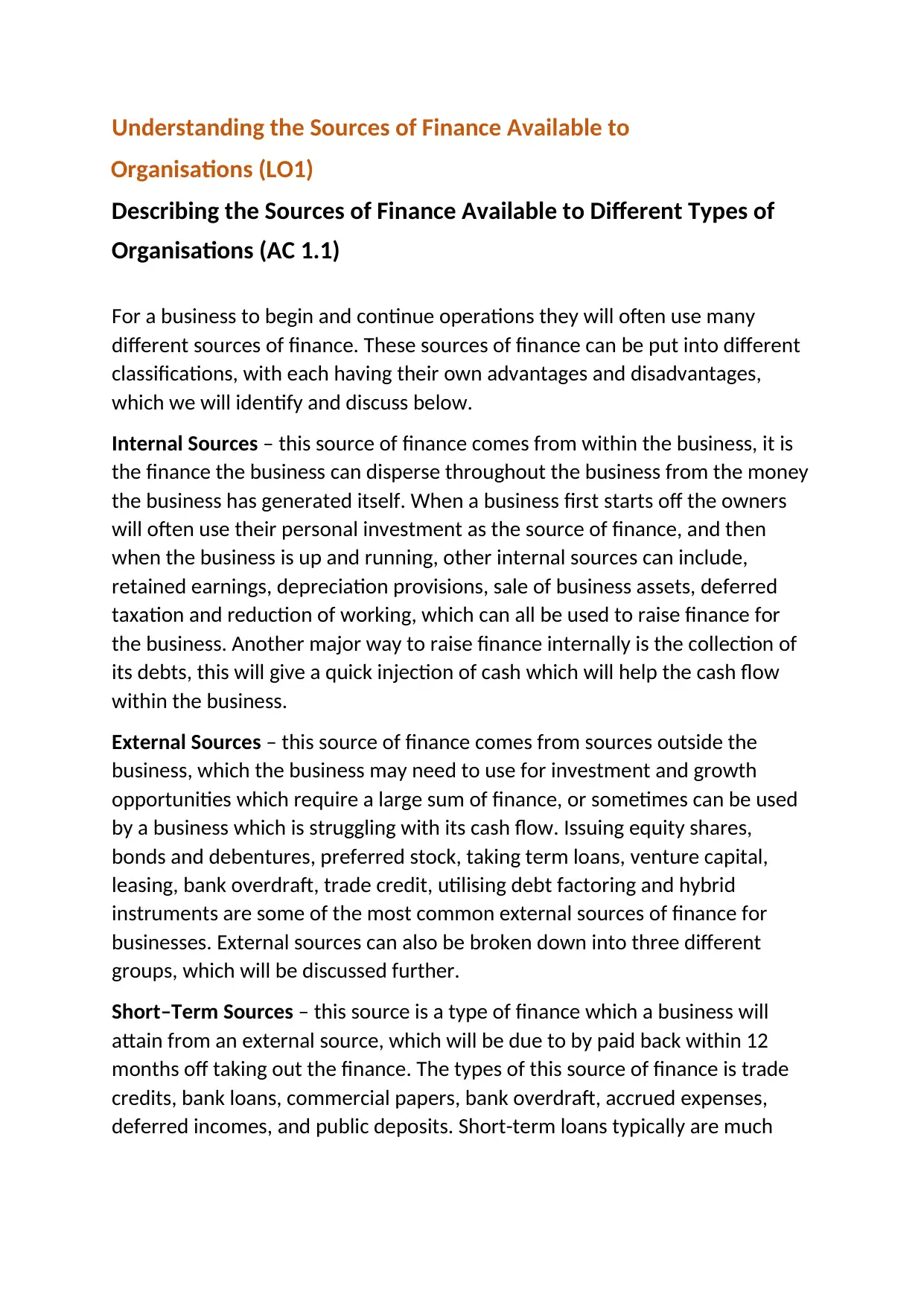
Understanding the Sources of Finance Available to
Organisations (LO1)
Describing the Sources of Finance Available to Different Types of
Organisations (AC 1.1)
For a business to begin and continue operations they will often use many
different sources of finance. These sources of finance can be put into different
classifications, with each having their own advantages and disadvantages,
which we will identify and discuss below.
Internal Sources – this source of finance comes from within the business, it is
the finance the business can disperse throughout the business from the money
the business has generated itself. When a business first starts off the owners
will often use their personal investment as the source of finance, and then
when the business is up and running, other internal sources can include,
retained earnings, depreciation provisions, sale of business assets, deferred
taxation and reduction of working, which can all be used to raise finance for
the business. Another major way to raise finance internally is the collection of
its debts, this will give a quick injection of cash which will help the cash flow
within the business.
External Sources – this source of finance comes from sources outside the
business, which the business may need to use for investment and growth
opportunities which require a large sum of finance, or sometimes can be used
by a business which is struggling with its cash flow. Issuing equity shares,
bonds and debentures, preferred stock, taking term loans, venture capital,
leasing, bank overdraft, trade credit, utilising debt factoring and hybrid
instruments are some of the most common external sources of finance for
businesses. External sources can also be broken down into three different
groups, which will be discussed further.
Short–Term Sources – this source is a type of finance which a business will
attain from an external source, which will be due to by paid back within 12
months off taking out the finance. The types of this source of finance is trade
credits, bank loans, commercial papers, bank overdraft, accrued expenses,
deferred incomes, and public deposits. Short-term loans typically are much
Organisations (LO1)
Describing the Sources of Finance Available to Different Types of
Organisations (AC 1.1)
For a business to begin and continue operations they will often use many
different sources of finance. These sources of finance can be put into different
classifications, with each having their own advantages and disadvantages,
which we will identify and discuss below.
Internal Sources – this source of finance comes from within the business, it is
the finance the business can disperse throughout the business from the money
the business has generated itself. When a business first starts off the owners
will often use their personal investment as the source of finance, and then
when the business is up and running, other internal sources can include,
retained earnings, depreciation provisions, sale of business assets, deferred
taxation and reduction of working, which can all be used to raise finance for
the business. Another major way to raise finance internally is the collection of
its debts, this will give a quick injection of cash which will help the cash flow
within the business.
External Sources – this source of finance comes from sources outside the
business, which the business may need to use for investment and growth
opportunities which require a large sum of finance, or sometimes can be used
by a business which is struggling with its cash flow. Issuing equity shares,
bonds and debentures, preferred stock, taking term loans, venture capital,
leasing, bank overdraft, trade credit, utilising debt factoring and hybrid
instruments are some of the most common external sources of finance for
businesses. External sources can also be broken down into three different
groups, which will be discussed further.
Short–Term Sources – this source is a type of finance which a business will
attain from an external source, which will be due to by paid back within 12
months off taking out the finance. The types of this source of finance is trade
credits, bank loans, commercial papers, bank overdraft, accrued expenses,
deferred incomes, and public deposits. Short-term loans typically are much
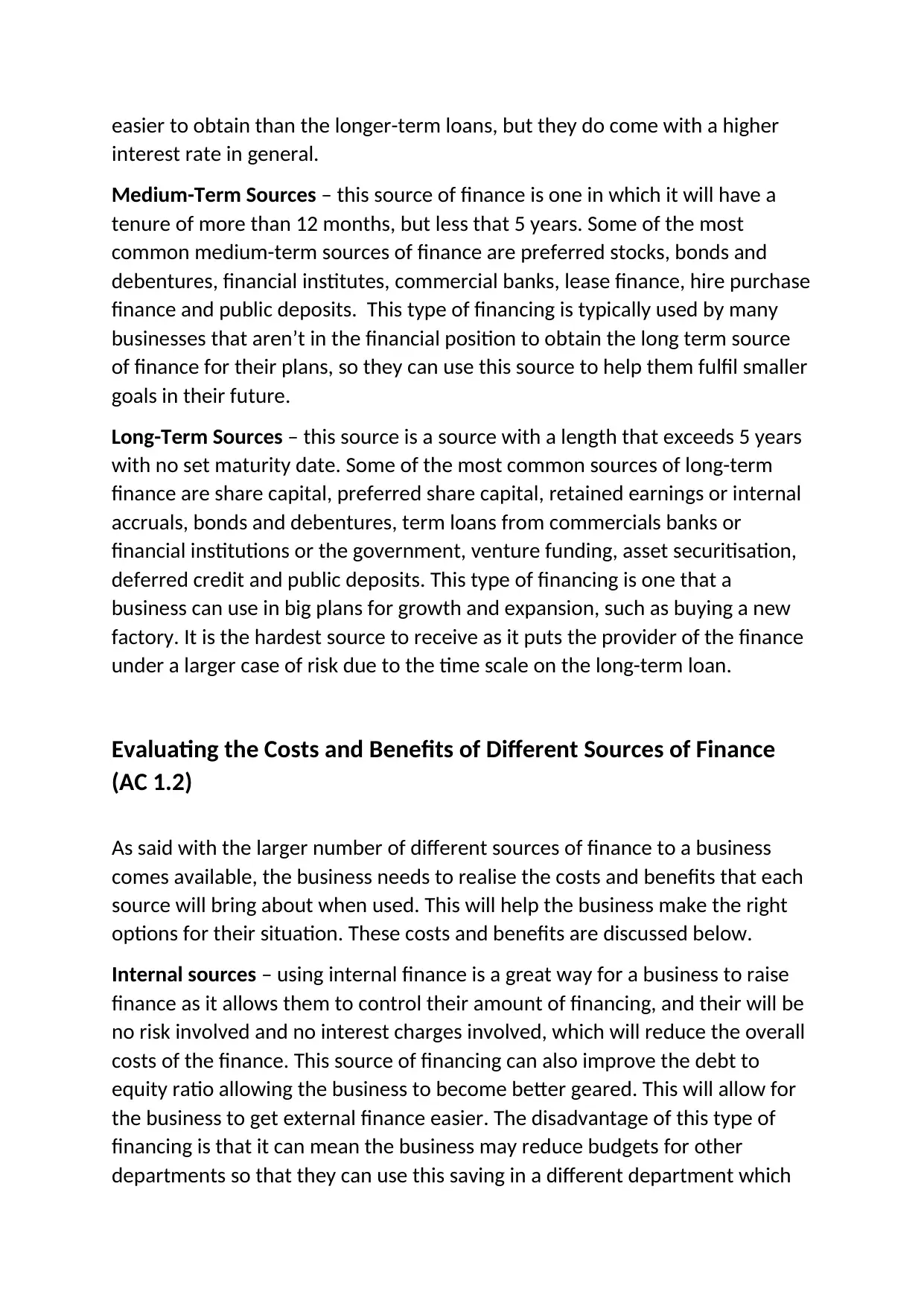
easier to obtain than the longer-term loans, but they do come with a higher
interest rate in general.
Medium-Term Sources – this source of finance is one in which it will have a
tenure of more than 12 months, but less that 5 years. Some of the most
common medium-term sources of finance are preferred stocks, bonds and
debentures, financial institutes, commercial banks, lease finance, hire purchase
finance and public deposits. This type of financing is typically used by many
businesses that aren’t in the financial position to obtain the long term source
of finance for their plans, so they can use this source to help them fulfil smaller
goals in their future.
Long-Term Sources – this source is a source with a length that exceeds 5 years
with no set maturity date. Some of the most common sources of long-term
finance are share capital, preferred share capital, retained earnings or internal
accruals, bonds and debentures, term loans from commercials banks or
financial institutions or the government, venture funding, asset securitisation,
deferred credit and public deposits. This type of financing is one that a
business can use in big plans for growth and expansion, such as buying a new
factory. It is the hardest source to receive as it puts the provider of the finance
under a larger case of risk due to the time scale on the long-term loan.
Evaluating the Costs and Benefits of Different Sources of Finance
(AC 1.2)
As said with the larger number of different sources of finance to a business
comes available, the business needs to realise the costs and benefits that each
source will bring about when used. This will help the business make the right
options for their situation. These costs and benefits are discussed below.
Internal sources – using internal finance is a great way for a business to raise
finance as it allows them to control their amount of financing, and their will be
no risk involved and no interest charges involved, which will reduce the overall
costs of the finance. This source of financing can also improve the debt to
equity ratio allowing the business to become better geared. This will allow for
the business to get external finance easier. The disadvantage of this type of
financing is that it can mean the business may reduce budgets for other
departments so that they can use this saving in a different department which
interest rate in general.
Medium-Term Sources – this source of finance is one in which it will have a
tenure of more than 12 months, but less that 5 years. Some of the most
common medium-term sources of finance are preferred stocks, bonds and
debentures, financial institutes, commercial banks, lease finance, hire purchase
finance and public deposits. This type of financing is typically used by many
businesses that aren’t in the financial position to obtain the long term source
of finance for their plans, so they can use this source to help them fulfil smaller
goals in their future.
Long-Term Sources – this source is a source with a length that exceeds 5 years
with no set maturity date. Some of the most common sources of long-term
finance are share capital, preferred share capital, retained earnings or internal
accruals, bonds and debentures, term loans from commercials banks or
financial institutions or the government, venture funding, asset securitisation,
deferred credit and public deposits. This type of financing is one that a
business can use in big plans for growth and expansion, such as buying a new
factory. It is the hardest source to receive as it puts the provider of the finance
under a larger case of risk due to the time scale on the long-term loan.
Evaluating the Costs and Benefits of Different Sources of Finance
(AC 1.2)
As said with the larger number of different sources of finance to a business
comes available, the business needs to realise the costs and benefits that each
source will bring about when used. This will help the business make the right
options for their situation. These costs and benefits are discussed below.
Internal sources – using internal finance is a great way for a business to raise
finance as it allows them to control their amount of financing, and their will be
no risk involved and no interest charges involved, which will reduce the overall
costs of the finance. This source of financing can also improve the debt to
equity ratio allowing the business to become better geared. This will allow for
the business to get external finance easier. The disadvantage of this type of
financing is that it can mean the business may reduce budgets for other
departments so that they can use this saving in a different department which
⊘ This is a preview!⊘
Do you want full access?
Subscribe today to unlock all pages.

Trusted by 1+ million students worldwide

can disrupt operations. This can also limit the available of outside insights and
increase the risk of bankruptcy for some businesses.
External Sources – external financing has many benefits which include how
sometimes they are necessary to keep a business afloat at short notices,
(overdrafts) and how they can be used to achieve growth projects that the
business would be unable to undertake without the additional help, however
they come with their disadvantages too, which could be how they can put the
business under more financial stress due to repayments with interest which
can damage a businesses cash flow, and how these sources may require the
business to use collateral with the loan agreements which would increase the
financial risk of bankruptcy for the business.
Issuing Share Capital – the benefits with this type of financing is that it can
help increase a business’ equity which can then be used in the future for a
business to attain debt easier such as a mortgage. The share capital does not
require monthly repayments as it is an investment, so it does not put the
business into financial risk of missing repayments. However, the business can
come across disadvantages with this type of finance such as how a high level of
share capital in a business can lead to the owners of the business losing a
degree of control as they will have a high number of shareholders which will
use their power to control certain decisions which could halt the owners
growth projections.
Banks Loans – the benefits of the bank loans a business can go for could be
how they allow for the owners of the business to maintain complete
ownership of the business so they can control the business decisions, the
business bank loan is also a temporary source of finance so once they are paid
off the business has no more obligation with the lender and therefore the
business can build their credit score. A disadvantage of the bank loans could be
how it can lead the business into becoming highly geared which then therefore
means the business will have to deal with high interest rates while trying to
maintain a good cash flow within the business.
Retained Earnings – this form of financing comes with advantages such as how
it can allow business to use their own profits in whatever way they want so
they can become self-dependent in their financing. This source does not
require applying for anything or setting up any repayments which lowers
financial risk. However it can cost the business in other areas such as how it
can deprive certain departments of the business as other areas get more
increase the risk of bankruptcy for some businesses.
External Sources – external financing has many benefits which include how
sometimes they are necessary to keep a business afloat at short notices,
(overdrafts) and how they can be used to achieve growth projects that the
business would be unable to undertake without the additional help, however
they come with their disadvantages too, which could be how they can put the
business under more financial stress due to repayments with interest which
can damage a businesses cash flow, and how these sources may require the
business to use collateral with the loan agreements which would increase the
financial risk of bankruptcy for the business.
Issuing Share Capital – the benefits with this type of financing is that it can
help increase a business’ equity which can then be used in the future for a
business to attain debt easier such as a mortgage. The share capital does not
require monthly repayments as it is an investment, so it does not put the
business into financial risk of missing repayments. However, the business can
come across disadvantages with this type of finance such as how a high level of
share capital in a business can lead to the owners of the business losing a
degree of control as they will have a high number of shareholders which will
use their power to control certain decisions which could halt the owners
growth projections.
Banks Loans – the benefits of the bank loans a business can go for could be
how they allow for the owners of the business to maintain complete
ownership of the business so they can control the business decisions, the
business bank loan is also a temporary source of finance so once they are paid
off the business has no more obligation with the lender and therefore the
business can build their credit score. A disadvantage of the bank loans could be
how it can lead the business into becoming highly geared which then therefore
means the business will have to deal with high interest rates while trying to
maintain a good cash flow within the business.
Retained Earnings – this form of financing comes with advantages such as how
it can allow business to use their own profits in whatever way they want so
they can become self-dependent in their financing. This source does not
require applying for anything or setting up any repayments which lowers
financial risk. However it can cost the business in other areas such as how it
can deprive certain departments of the business as other areas get more
Paraphrase This Document
Need a fresh take? Get an instant paraphrase of this document with our AI Paraphraser
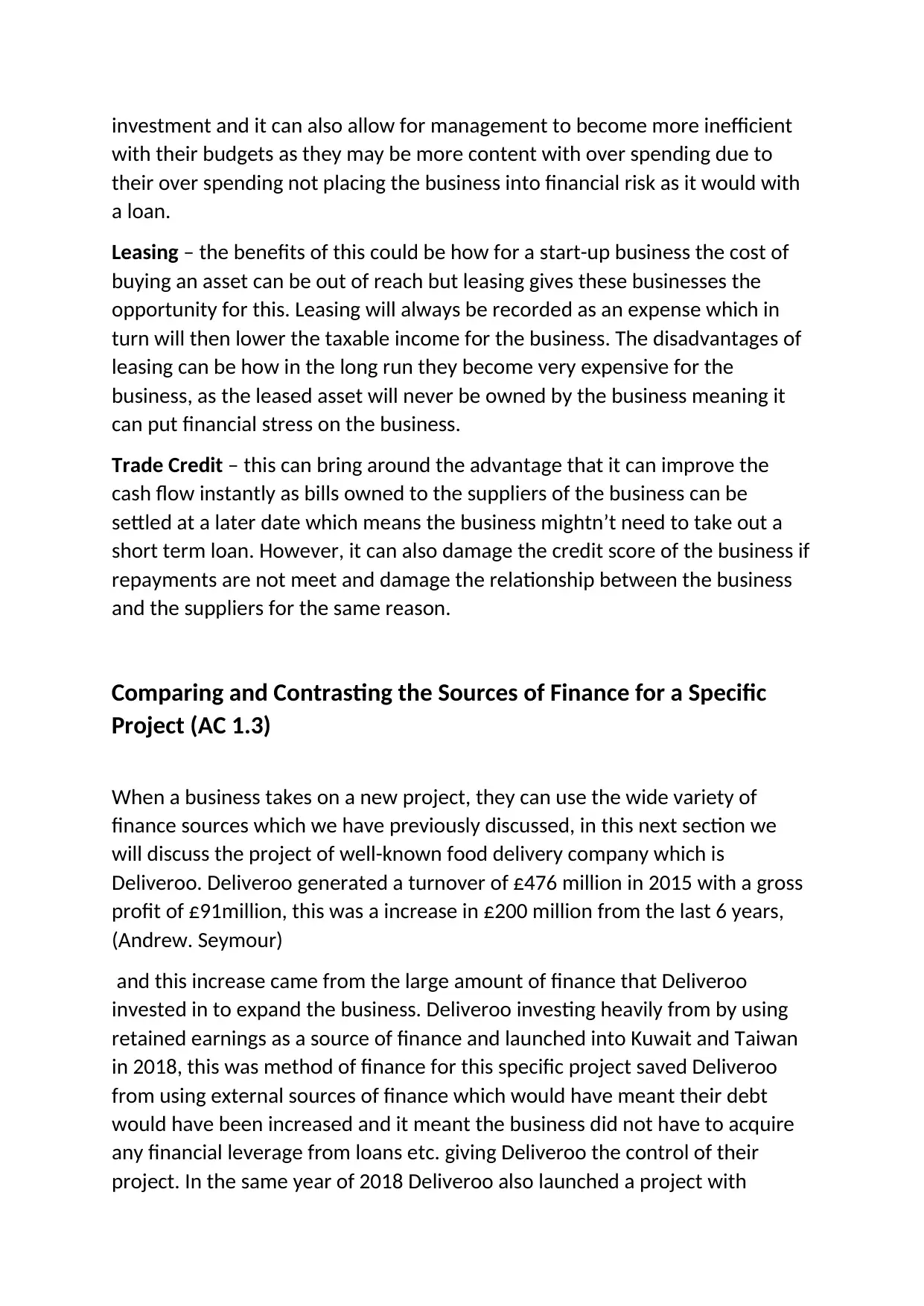
investment and it can also allow for management to become more inefficient
with their budgets as they may be more content with over spending due to
their over spending not placing the business into financial risk as it would with
a loan.
Leasing – the benefits of this could be how for a start-up business the cost of
buying an asset can be out of reach but leasing gives these businesses the
opportunity for this. Leasing will always be recorded as an expense which in
turn will then lower the taxable income for the business. The disadvantages of
leasing can be how in the long run they become very expensive for the
business, as the leased asset will never be owned by the business meaning it
can put financial stress on the business.
Trade Credit – this can bring around the advantage that it can improve the
cash flow instantly as bills owned to the suppliers of the business can be
settled at a later date which means the business mightn’t need to take out a
short term loan. However, it can also damage the credit score of the business if
repayments are not meet and damage the relationship between the business
and the suppliers for the same reason.
Comparing and Contrasting the Sources of Finance for a Specific
Project (AC 1.3)
When a business takes on a new project, they can use the wide variety of
finance sources which we have previously discussed, in this next section we
will discuss the project of well-known food delivery company which is
Deliveroo. Deliveroo generated a turnover of £476 million in 2015 with a gross
profit of £91million, this was a increase in £200 million from the last 6 years,
(Andrew. Seymour)
and this increase came from the large amount of finance that Deliveroo
invested in to expand the business. Deliveroo investing heavily from by using
retained earnings as a source of finance and launched into Kuwait and Taiwan
in 2018, this was method of finance for this specific project saved Deliveroo
from using external sources of finance which would have meant their debt
would have been increased and it meant the business did not have to acquire
any financial leverage from loans etc. giving Deliveroo the control of their
project. In the same year of 2018 Deliveroo also launched a project with
with their budgets as they may be more content with over spending due to
their over spending not placing the business into financial risk as it would with
a loan.
Leasing – the benefits of this could be how for a start-up business the cost of
buying an asset can be out of reach but leasing gives these businesses the
opportunity for this. Leasing will always be recorded as an expense which in
turn will then lower the taxable income for the business. The disadvantages of
leasing can be how in the long run they become very expensive for the
business, as the leased asset will never be owned by the business meaning it
can put financial stress on the business.
Trade Credit – this can bring around the advantage that it can improve the
cash flow instantly as bills owned to the suppliers of the business can be
settled at a later date which means the business mightn’t need to take out a
short term loan. However, it can also damage the credit score of the business if
repayments are not meet and damage the relationship between the business
and the suppliers for the same reason.
Comparing and Contrasting the Sources of Finance for a Specific
Project (AC 1.3)
When a business takes on a new project, they can use the wide variety of
finance sources which we have previously discussed, in this next section we
will discuss the project of well-known food delivery company which is
Deliveroo. Deliveroo generated a turnover of £476 million in 2015 with a gross
profit of £91million, this was a increase in £200 million from the last 6 years,
(Andrew. Seymour)
and this increase came from the large amount of finance that Deliveroo
invested in to expand the business. Deliveroo investing heavily from by using
retained earnings as a source of finance and launched into Kuwait and Taiwan
in 2018, this was method of finance for this specific project saved Deliveroo
from using external sources of finance which would have meant their debt
would have been increased and it meant the business did not have to acquire
any financial leverage from loans etc. giving Deliveroo the control of their
project. In the same year of 2018 Deliveroo also launched a project with
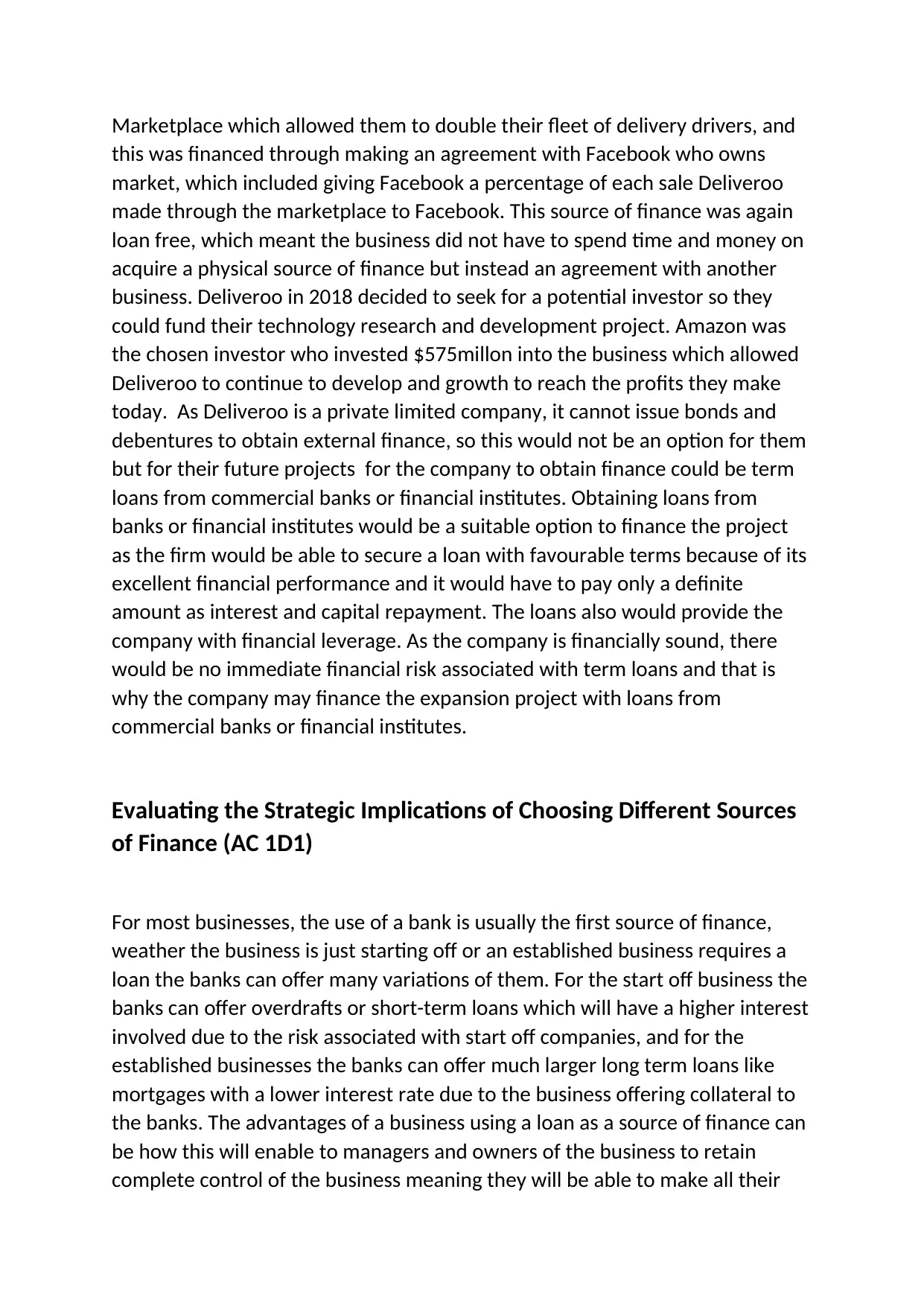
Marketplace which allowed them to double their fleet of delivery drivers, and
this was financed through making an agreement with Facebook who owns
market, which included giving Facebook a percentage of each sale Deliveroo
made through the marketplace to Facebook. This source of finance was again
loan free, which meant the business did not have to spend time and money on
acquire a physical source of finance but instead an agreement with another
business. Deliveroo in 2018 decided to seek for a potential investor so they
could fund their technology research and development project. Amazon was
the chosen investor who invested $575millon into the business which allowed
Deliveroo to continue to develop and growth to reach the profits they make
today. As Deliveroo is a private limited company, it cannot issue bonds and
debentures to obtain external finance, so this would not be an option for them
but for their future projects for the company to obtain finance could be term
loans from commercial banks or financial institutes. Obtaining loans from
banks or financial institutes would be a suitable option to finance the project
as the firm would be able to secure a loan with favourable terms because of its
excellent financial performance and it would have to pay only a definite
amount as interest and capital repayment. The loans also would provide the
company with financial leverage. As the company is financially sound, there
would be no immediate financial risk associated with term loans and that is
why the company may finance the expansion project with loans from
commercial banks or financial institutes.
Evaluating the Strategic Implications of Choosing Different Sources
of Finance (AC 1D1)
For most businesses, the use of a bank is usually the first source of finance,
weather the business is just starting off or an established business requires a
loan the banks can offer many variations of them. For the start off business the
banks can offer overdrafts or short-term loans which will have a higher interest
involved due to the risk associated with start off companies, and for the
established businesses the banks can offer much larger long term loans like
mortgages with a lower interest rate due to the business offering collateral to
the banks. The advantages of a business using a loan as a source of finance can
be how this will enable to managers and owners of the business to retain
complete control of the business meaning they will be able to make all their
this was financed through making an agreement with Facebook who owns
market, which included giving Facebook a percentage of each sale Deliveroo
made through the marketplace to Facebook. This source of finance was again
loan free, which meant the business did not have to spend time and money on
acquire a physical source of finance but instead an agreement with another
business. Deliveroo in 2018 decided to seek for a potential investor so they
could fund their technology research and development project. Amazon was
the chosen investor who invested $575millon into the business which allowed
Deliveroo to continue to develop and growth to reach the profits they make
today. As Deliveroo is a private limited company, it cannot issue bonds and
debentures to obtain external finance, so this would not be an option for them
but for their future projects for the company to obtain finance could be term
loans from commercial banks or financial institutes. Obtaining loans from
banks or financial institutes would be a suitable option to finance the project
as the firm would be able to secure a loan with favourable terms because of its
excellent financial performance and it would have to pay only a definite
amount as interest and capital repayment. The loans also would provide the
company with financial leverage. As the company is financially sound, there
would be no immediate financial risk associated with term loans and that is
why the company may finance the expansion project with loans from
commercial banks or financial institutes.
Evaluating the Strategic Implications of Choosing Different Sources
of Finance (AC 1D1)
For most businesses, the use of a bank is usually the first source of finance,
weather the business is just starting off or an established business requires a
loan the banks can offer many variations of them. For the start off business the
banks can offer overdrafts or short-term loans which will have a higher interest
involved due to the risk associated with start off companies, and for the
established businesses the banks can offer much larger long term loans like
mortgages with a lower interest rate due to the business offering collateral to
the banks. The advantages of a business using a loan as a source of finance can
be how this will enable to managers and owners of the business to retain
complete control of the business meaning they will be able to make all their
⊘ This is a preview!⊘
Do you want full access?
Subscribe today to unlock all pages.

Trusted by 1+ million students worldwide
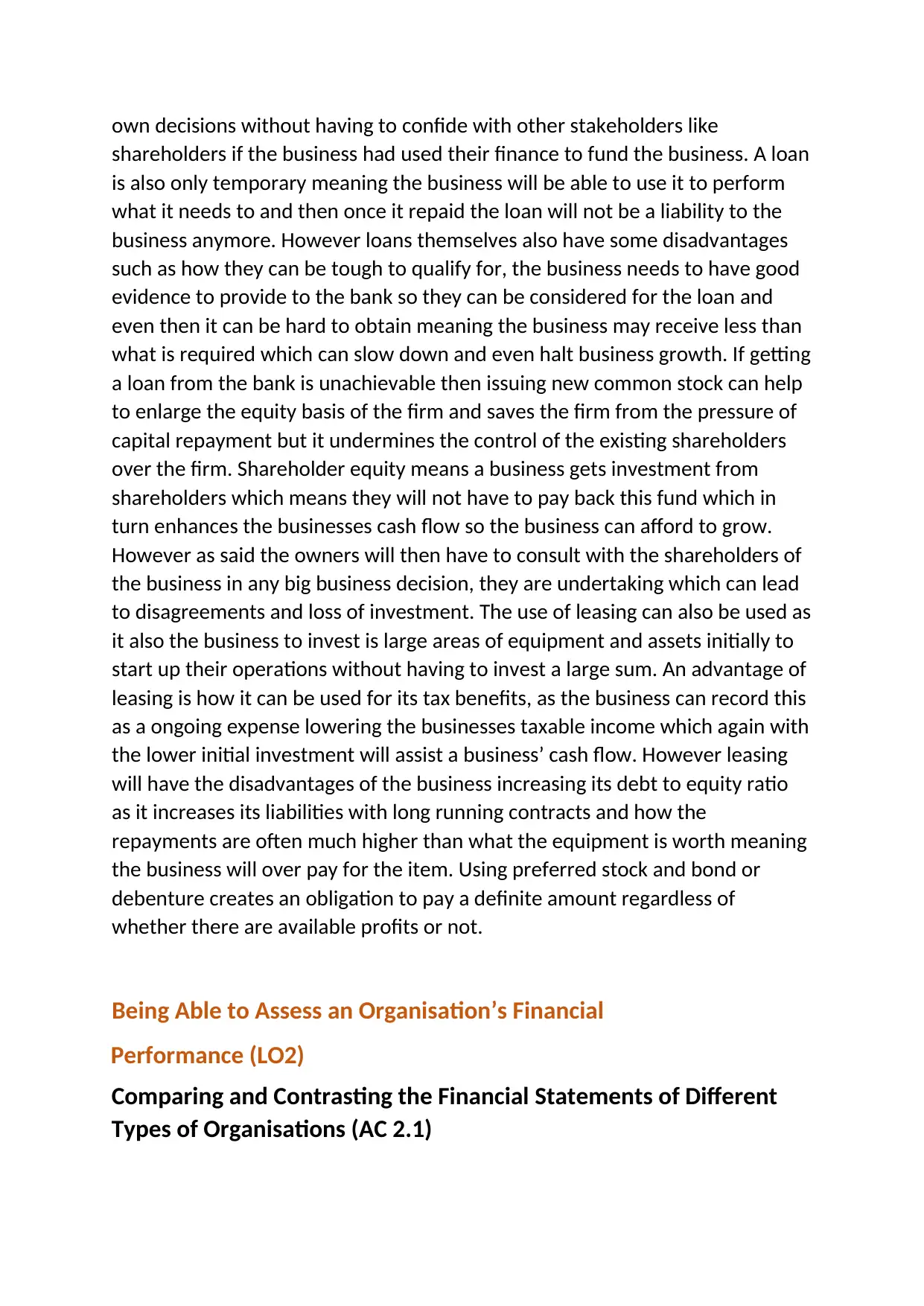
own decisions without having to confide with other stakeholders like
shareholders if the business had used their finance to fund the business. A loan
is also only temporary meaning the business will be able to use it to perform
what it needs to and then once it repaid the loan will not be a liability to the
business anymore. However loans themselves also have some disadvantages
such as how they can be tough to qualify for, the business needs to have good
evidence to provide to the bank so they can be considered for the loan and
even then it can be hard to obtain meaning the business may receive less than
what is required which can slow down and even halt business growth. If getting
a loan from the bank is unachievable then issuing new common stock can help
to enlarge the equity basis of the firm and saves the firm from the pressure of
capital repayment but it undermines the control of the existing shareholders
over the firm. Shareholder equity means a business gets investment from
shareholders which means they will not have to pay back this fund which in
turn enhances the businesses cash flow so the business can afford to grow.
However as said the owners will then have to consult with the shareholders of
the business in any big business decision, they are undertaking which can lead
to disagreements and loss of investment. The use of leasing can also be used as
it also the business to invest is large areas of equipment and assets initially to
start up their operations without having to invest a large sum. An advantage of
leasing is how it can be used for its tax benefits, as the business can record this
as a ongoing expense lowering the businesses taxable income which again with
the lower initial investment will assist a business’ cash flow. However leasing
will have the disadvantages of the business increasing its debt to equity ratio
as it increases its liabilities with long running contracts and how the
repayments are often much higher than what the equipment is worth meaning
the business will over pay for the item. Using preferred stock and bond or
debenture creates an obligation to pay a definite amount regardless of
whether there are available profits or not.
Being Able to Assess an Organisation’s Financial
Performance (LO2)
Comparing and Contrasting the Financial Statements of Different
Types of Organisations (AC 2.1)
shareholders if the business had used their finance to fund the business. A loan
is also only temporary meaning the business will be able to use it to perform
what it needs to and then once it repaid the loan will not be a liability to the
business anymore. However loans themselves also have some disadvantages
such as how they can be tough to qualify for, the business needs to have good
evidence to provide to the bank so they can be considered for the loan and
even then it can be hard to obtain meaning the business may receive less than
what is required which can slow down and even halt business growth. If getting
a loan from the bank is unachievable then issuing new common stock can help
to enlarge the equity basis of the firm and saves the firm from the pressure of
capital repayment but it undermines the control of the existing shareholders
over the firm. Shareholder equity means a business gets investment from
shareholders which means they will not have to pay back this fund which in
turn enhances the businesses cash flow so the business can afford to grow.
However as said the owners will then have to consult with the shareholders of
the business in any big business decision, they are undertaking which can lead
to disagreements and loss of investment. The use of leasing can also be used as
it also the business to invest is large areas of equipment and assets initially to
start up their operations without having to invest a large sum. An advantage of
leasing is how it can be used for its tax benefits, as the business can record this
as a ongoing expense lowering the businesses taxable income which again with
the lower initial investment will assist a business’ cash flow. However leasing
will have the disadvantages of the business increasing its debt to equity ratio
as it increases its liabilities with long running contracts and how the
repayments are often much higher than what the equipment is worth meaning
the business will over pay for the item. Using preferred stock and bond or
debenture creates an obligation to pay a definite amount regardless of
whether there are available profits or not.
Being Able to Assess an Organisation’s Financial
Performance (LO2)
Comparing and Contrasting the Financial Statements of Different
Types of Organisations (AC 2.1)
Paraphrase This Document
Need a fresh take? Get an instant paraphrase of this document with our AI Paraphraser
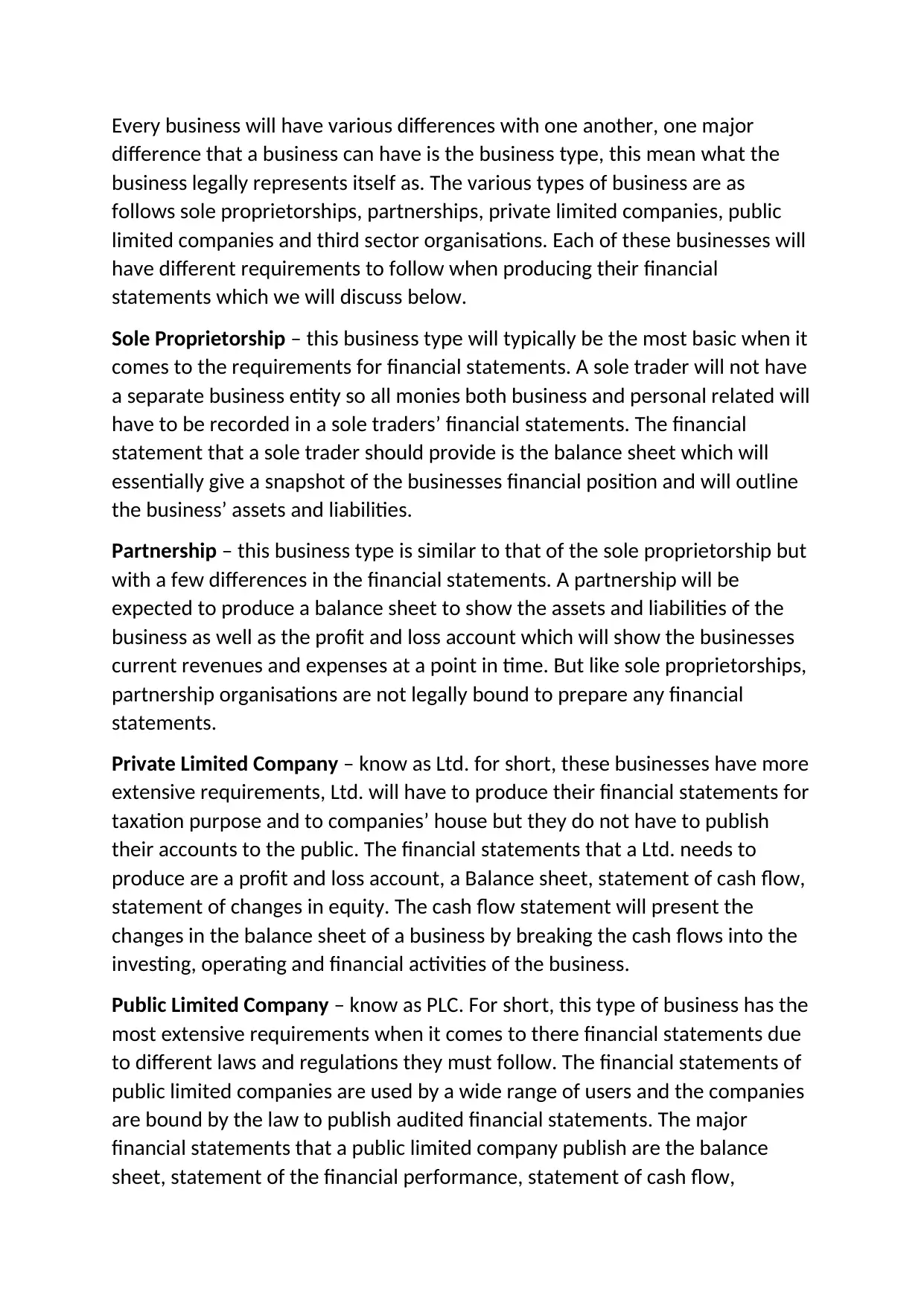
Every business will have various differences with one another, one major
difference that a business can have is the business type, this mean what the
business legally represents itself as. The various types of business are as
follows sole proprietorships, partnerships, private limited companies, public
limited companies and third sector organisations. Each of these businesses will
have different requirements to follow when producing their financial
statements which we will discuss below.
Sole Proprietorship – this business type will typically be the most basic when it
comes to the requirements for financial statements. A sole trader will not have
a separate business entity so all monies both business and personal related will
have to be recorded in a sole traders’ financial statements. The financial
statement that a sole trader should provide is the balance sheet which will
essentially give a snapshot of the businesses financial position and will outline
the business’ assets and liabilities.
Partnership – this business type is similar to that of the sole proprietorship but
with a few differences in the financial statements. A partnership will be
expected to produce a balance sheet to show the assets and liabilities of the
business as well as the profit and loss account which will show the businesses
current revenues and expenses at a point in time. But like sole proprietorships,
partnership organisations are not legally bound to prepare any financial
statements.
Private Limited Company – know as Ltd. for short, these businesses have more
extensive requirements, Ltd. will have to produce their financial statements for
taxation purpose and to companies’ house but they do not have to publish
their accounts to the public. The financial statements that a Ltd. needs to
produce are a profit and loss account, a Balance sheet, statement of cash flow,
statement of changes in equity. The cash flow statement will present the
changes in the balance sheet of a business by breaking the cash flows into the
investing, operating and financial activities of the business.
Public Limited Company – know as PLC. For short, this type of business has the
most extensive requirements when it comes to there financial statements due
to different laws and regulations they must follow. The financial statements of
public limited companies are used by a wide range of users and the companies
are bound by the law to publish audited financial statements. The major
financial statements that a public limited company publish are the balance
sheet, statement of the financial performance, statement of cash flow,
difference that a business can have is the business type, this mean what the
business legally represents itself as. The various types of business are as
follows sole proprietorships, partnerships, private limited companies, public
limited companies and third sector organisations. Each of these businesses will
have different requirements to follow when producing their financial
statements which we will discuss below.
Sole Proprietorship – this business type will typically be the most basic when it
comes to the requirements for financial statements. A sole trader will not have
a separate business entity so all monies both business and personal related will
have to be recorded in a sole traders’ financial statements. The financial
statement that a sole trader should provide is the balance sheet which will
essentially give a snapshot of the businesses financial position and will outline
the business’ assets and liabilities.
Partnership – this business type is similar to that of the sole proprietorship but
with a few differences in the financial statements. A partnership will be
expected to produce a balance sheet to show the assets and liabilities of the
business as well as the profit and loss account which will show the businesses
current revenues and expenses at a point in time. But like sole proprietorships,
partnership organisations are not legally bound to prepare any financial
statements.
Private Limited Company – know as Ltd. for short, these businesses have more
extensive requirements, Ltd. will have to produce their financial statements for
taxation purpose and to companies’ house but they do not have to publish
their accounts to the public. The financial statements that a Ltd. needs to
produce are a profit and loss account, a Balance sheet, statement of cash flow,
statement of changes in equity. The cash flow statement will present the
changes in the balance sheet of a business by breaking the cash flows into the
investing, operating and financial activities of the business.
Public Limited Company – know as PLC. For short, this type of business has the
most extensive requirements when it comes to there financial statements due
to different laws and regulations they must follow. The financial statements of
public limited companies are used by a wide range of users and the companies
are bound by the law to publish audited financial statements. The major
financial statements that a public limited company publish are the balance
sheet, statement of the financial performance, statement of cash flow,
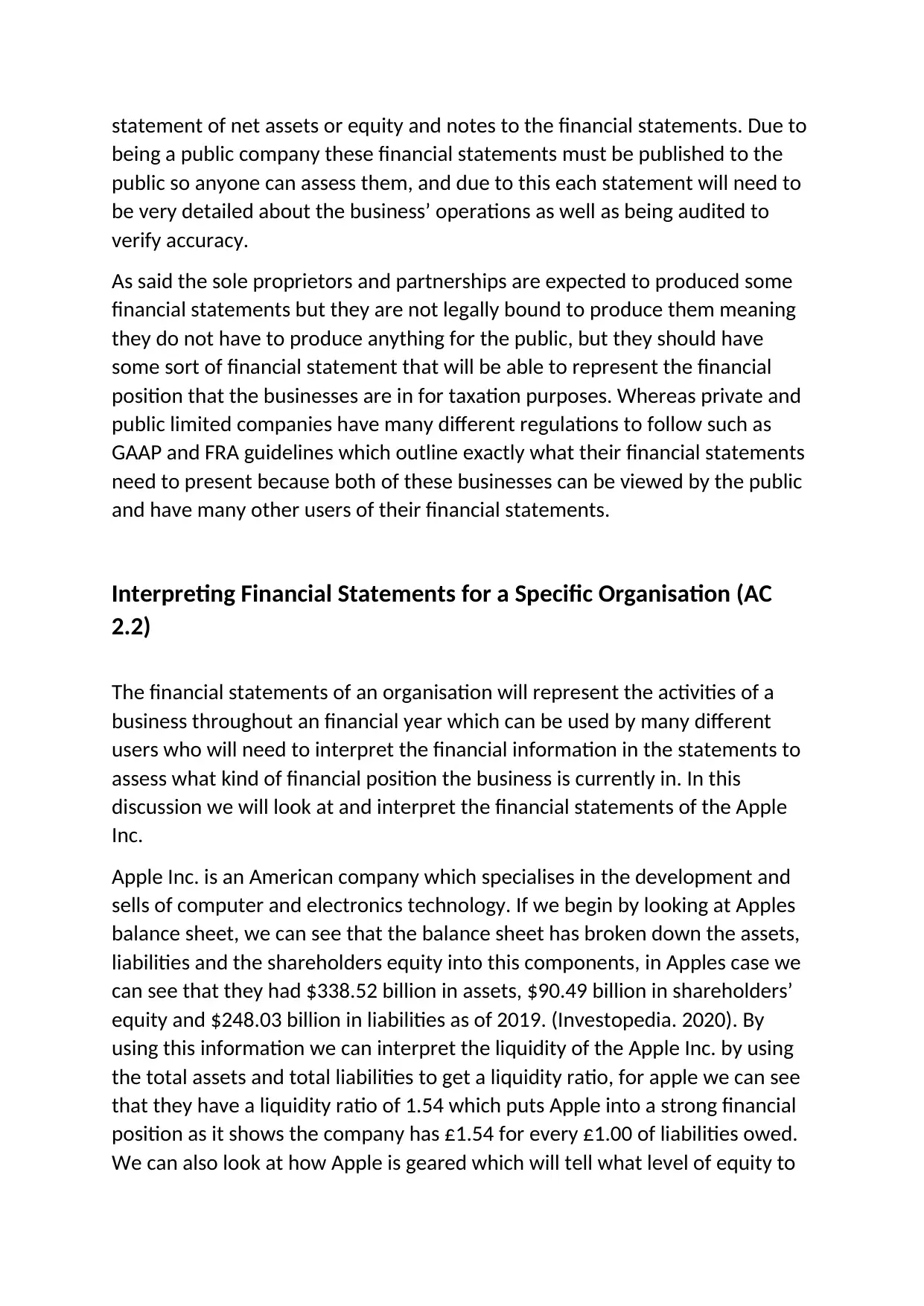
statement of net assets or equity and notes to the financial statements. Due to
being a public company these financial statements must be published to the
public so anyone can assess them, and due to this each statement will need to
be very detailed about the business’ operations as well as being audited to
verify accuracy.
As said the sole proprietors and partnerships are expected to produced some
financial statements but they are not legally bound to produce them meaning
they do not have to produce anything for the public, but they should have
some sort of financial statement that will be able to represent the financial
position that the businesses are in for taxation purposes. Whereas private and
public limited companies have many different regulations to follow such as
GAAP and FRA guidelines which outline exactly what their financial statements
need to present because both of these businesses can be viewed by the public
and have many other users of their financial statements.
Interpreting Financial Statements for a Specific Organisation (AC
2.2)
The financial statements of an organisation will represent the activities of a
business throughout an financial year which can be used by many different
users who will need to interpret the financial information in the statements to
assess what kind of financial position the business is currently in. In this
discussion we will look at and interpret the financial statements of the Apple
Inc.
Apple Inc. is an American company which specialises in the development and
sells of computer and electronics technology. If we begin by looking at Apples
balance sheet, we can see that the balance sheet has broken down the assets,
liabilities and the shareholders equity into this components, in Apples case we
can see that they had $338.52 billion in assets, $90.49 billion in shareholders’
equity and $248.03 billion in liabilities as of 2019. (Investopedia. 2020). By
using this information we can interpret the liquidity of the Apple Inc. by using
the total assets and total liabilities to get a liquidity ratio, for apple we can see
that they have a liquidity ratio of 1.54 which puts Apple into a strong financial
position as it shows the company has £1.54 for every £1.00 of liabilities owed.
We can also look at how Apple is geared which will tell what level of equity to
being a public company these financial statements must be published to the
public so anyone can assess them, and due to this each statement will need to
be very detailed about the business’ operations as well as being audited to
verify accuracy.
As said the sole proprietors and partnerships are expected to produced some
financial statements but they are not legally bound to produce them meaning
they do not have to produce anything for the public, but they should have
some sort of financial statement that will be able to represent the financial
position that the businesses are in for taxation purposes. Whereas private and
public limited companies have many different regulations to follow such as
GAAP and FRA guidelines which outline exactly what their financial statements
need to present because both of these businesses can be viewed by the public
and have many other users of their financial statements.
Interpreting Financial Statements for a Specific Organisation (AC
2.2)
The financial statements of an organisation will represent the activities of a
business throughout an financial year which can be used by many different
users who will need to interpret the financial information in the statements to
assess what kind of financial position the business is currently in. In this
discussion we will look at and interpret the financial statements of the Apple
Inc.
Apple Inc. is an American company which specialises in the development and
sells of computer and electronics technology. If we begin by looking at Apples
balance sheet, we can see that the balance sheet has broken down the assets,
liabilities and the shareholders equity into this components, in Apples case we
can see that they had $338.52 billion in assets, $90.49 billion in shareholders’
equity and $248.03 billion in liabilities as of 2019. (Investopedia. 2020). By
using this information we can interpret the liquidity of the Apple Inc. by using
the total assets and total liabilities to get a liquidity ratio, for apple we can see
that they have a liquidity ratio of 1.54 which puts Apple into a strong financial
position as it shows the company has £1.54 for every £1.00 of liabilities owed.
We can also look at how Apple is geared which will tell what level of equity to
⊘ This is a preview!⊘
Do you want full access?
Subscribe today to unlock all pages.

Trusted by 1+ million students worldwide

debt the business has. In the case of Apple, we can see that they have a debt-
to-equity ratio of 1.32, which means the company has more debt than equity
but it is still in a strong financial position in regards to this. Apples accounts
receivables will represent the sum of what Apple is owed by its customers and
other companies which is at a level of $14.1 billion, which can be for products,
retailers, and wholesalers for example, this is because apple offer credit giving
these debtors time to pay the bill. Due to this high sum of accounts receivable
apple could be at a high risk, as some of this sum may never be paid by the
debtors, leaving room for cash flow problems. Overall, it seems after looking at
Apple Inc. financial statements it seems that they are performing well which
could be down to a good management style, however it is worth noting that
these financial statements only give the users a snapshot of the business at a
point in time which users should keep in mind.
Reviewing the Ethical Requirements Associated with Financial
Statements of Third Sector Organisations (AC 2M1)
A third sector organisation is defined as being an organisation that is neither in
the private or public sector and is one that includes registered charities and
community, voluntary organisations. The main requirement to be classified as
a third sector organisation is that the organisation must operate solely for the
purpose of providing a charitable service in relation to the public needs and
concerns. Due to strict guidelines on third sector organisations, their financial
statements must also follow strict guidelines and be completely transparent.
These financial statements need to provide all the information about how the
third sector organisation has spent its income and the executive remuneration
of the organisation. The responsibilities of the shareholders in third sector
organisations are different from typical shareholders as shareholders in public
and private shareholders look for ways how they can maximise on there
profits, where as shareholders in third sector organisations must look on ways
how to maximise the value in the interest of the beneficiaries. Third sectors
need to be completely open when they are preparing their financial
statements which needs to include details of how the organisation is receiving
the funds and how the funds are being utilised. The efficiency of the utilisation
of funds should be illustrated in the statements. The statements need to show
how each of their donations are being used with an explanation of where,
to-equity ratio of 1.32, which means the company has more debt than equity
but it is still in a strong financial position in regards to this. Apples accounts
receivables will represent the sum of what Apple is owed by its customers and
other companies which is at a level of $14.1 billion, which can be for products,
retailers, and wholesalers for example, this is because apple offer credit giving
these debtors time to pay the bill. Due to this high sum of accounts receivable
apple could be at a high risk, as some of this sum may never be paid by the
debtors, leaving room for cash flow problems. Overall, it seems after looking at
Apple Inc. financial statements it seems that they are performing well which
could be down to a good management style, however it is worth noting that
these financial statements only give the users a snapshot of the business at a
point in time which users should keep in mind.
Reviewing the Ethical Requirements Associated with Financial
Statements of Third Sector Organisations (AC 2M1)
A third sector organisation is defined as being an organisation that is neither in
the private or public sector and is one that includes registered charities and
community, voluntary organisations. The main requirement to be classified as
a third sector organisation is that the organisation must operate solely for the
purpose of providing a charitable service in relation to the public needs and
concerns. Due to strict guidelines on third sector organisations, their financial
statements must also follow strict guidelines and be completely transparent.
These financial statements need to provide all the information about how the
third sector organisation has spent its income and the executive remuneration
of the organisation. The responsibilities of the shareholders in third sector
organisations are different from typical shareholders as shareholders in public
and private shareholders look for ways how they can maximise on there
profits, where as shareholders in third sector organisations must look on ways
how to maximise the value in the interest of the beneficiaries. Third sectors
need to be completely open when they are preparing their financial
statements which needs to include details of how the organisation is receiving
the funds and how the funds are being utilised. The efficiency of the utilisation
of funds should be illustrated in the statements. The statements need to show
how each of their donations are being used with an explanation of where,
Paraphrase This Document
Need a fresh take? Get an instant paraphrase of this document with our AI Paraphraser
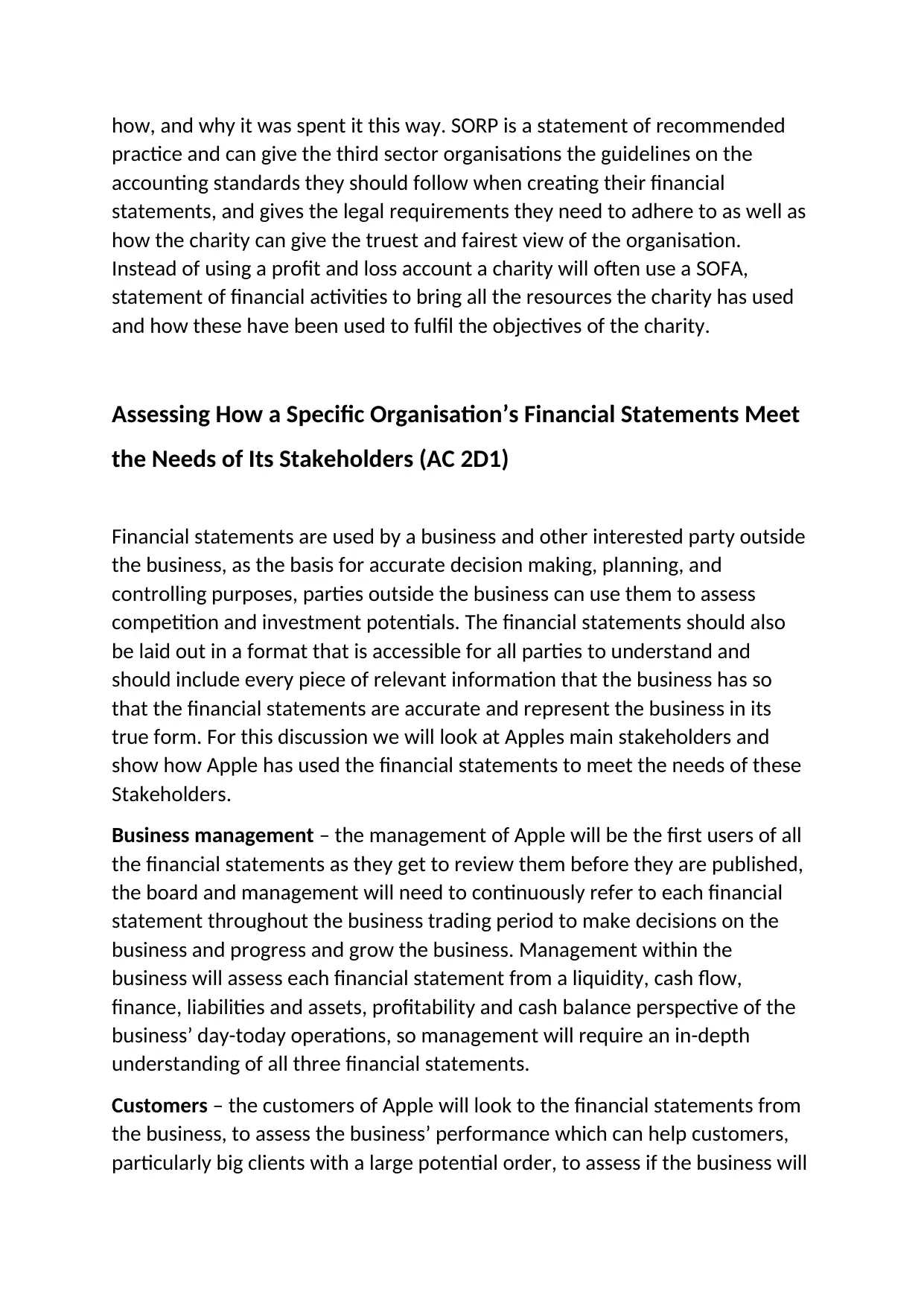
how, and why it was spent it this way. SORP is a statement of recommended
practice and can give the third sector organisations the guidelines on the
accounting standards they should follow when creating their financial
statements, and gives the legal requirements they need to adhere to as well as
how the charity can give the truest and fairest view of the organisation.
Instead of using a profit and loss account a charity will often use a SOFA,
statement of financial activities to bring all the resources the charity has used
and how these have been used to fulfil the objectives of the charity.
Assessing How a Specific Organisation’s Financial Statements Meet
the Needs of Its Stakeholders (AC 2D1)
Financial statements are used by a business and other interested party outside
the business, as the basis for accurate decision making, planning, and
controlling purposes, parties outside the business can use them to assess
competition and investment potentials. The financial statements should also
be laid out in a format that is accessible for all parties to understand and
should include every piece of relevant information that the business has so
that the financial statements are accurate and represent the business in its
true form. For this discussion we will look at Apples main stakeholders and
show how Apple has used the financial statements to meet the needs of these
Stakeholders.
Business management – the management of Apple will be the first users of all
the financial statements as they get to review them before they are published,
the board and management will need to continuously refer to each financial
statement throughout the business trading period to make decisions on the
business and progress and grow the business. Management within the
business will assess each financial statement from a liquidity, cash flow,
finance, liabilities and assets, profitability and cash balance perspective of the
business’ day-today operations, so management will require an in-depth
understanding of all three financial statements.
Customers – the customers of Apple will look to the financial statements from
the business, to assess the business’ performance which can help customers,
particularly big clients with a large potential order, to assess if the business will
practice and can give the third sector organisations the guidelines on the
accounting standards they should follow when creating their financial
statements, and gives the legal requirements they need to adhere to as well as
how the charity can give the truest and fairest view of the organisation.
Instead of using a profit and loss account a charity will often use a SOFA,
statement of financial activities to bring all the resources the charity has used
and how these have been used to fulfil the objectives of the charity.
Assessing How a Specific Organisation’s Financial Statements Meet
the Needs of Its Stakeholders (AC 2D1)
Financial statements are used by a business and other interested party outside
the business, as the basis for accurate decision making, planning, and
controlling purposes, parties outside the business can use them to assess
competition and investment potentials. The financial statements should also
be laid out in a format that is accessible for all parties to understand and
should include every piece of relevant information that the business has so
that the financial statements are accurate and represent the business in its
true form. For this discussion we will look at Apples main stakeholders and
show how Apple has used the financial statements to meet the needs of these
Stakeholders.
Business management – the management of Apple will be the first users of all
the financial statements as they get to review them before they are published,
the board and management will need to continuously refer to each financial
statement throughout the business trading period to make decisions on the
business and progress and grow the business. Management within the
business will assess each financial statement from a liquidity, cash flow,
finance, liabilities and assets, profitability and cash balance perspective of the
business’ day-today operations, so management will require an in-depth
understanding of all three financial statements.
Customers – the customers of Apple will look to the financial statements from
the business, to assess the business’ performance which can help customers,
particularly big clients with a large potential order, to assess if the business will
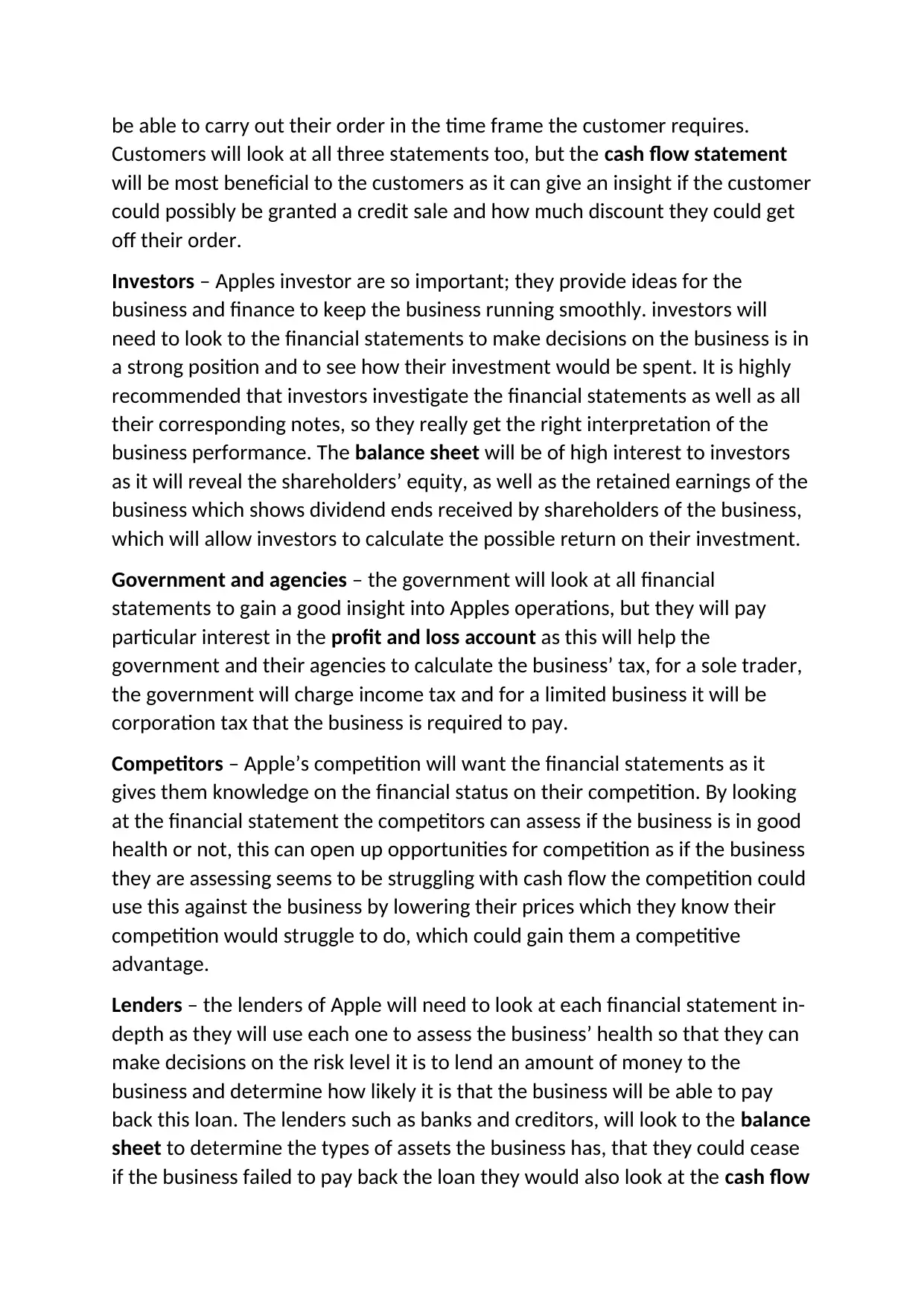
be able to carry out their order in the time frame the customer requires.
Customers will look at all three statements too, but the cash flow statement
will be most beneficial to the customers as it can give an insight if the customer
could possibly be granted a credit sale and how much discount they could get
off their order.
Investors – Apples investor are so important; they provide ideas for the
business and finance to keep the business running smoothly. investors will
need to look to the financial statements to make decisions on the business is in
a strong position and to see how their investment would be spent. It is highly
recommended that investors investigate the financial statements as well as all
their corresponding notes, so they really get the right interpretation of the
business performance. The balance sheet will be of high interest to investors
as it will reveal the shareholders’ equity, as well as the retained earnings of the
business which shows dividend ends received by shareholders of the business,
which will allow investors to calculate the possible return on their investment.
Government and agencies – the government will look at all financial
statements to gain a good insight into Apples operations, but they will pay
particular interest in the profit and loss account as this will help the
government and their agencies to calculate the business’ tax, for a sole trader,
the government will charge income tax and for a limited business it will be
corporation tax that the business is required to pay.
Competitors – Apple’s competition will want the financial statements as it
gives them knowledge on the financial status on their competition. By looking
at the financial statement the competitors can assess if the business is in good
health or not, this can open up opportunities for competition as if the business
they are assessing seems to be struggling with cash flow the competition could
use this against the business by lowering their prices which they know their
competition would struggle to do, which could gain them a competitive
advantage.
Lenders – the lenders of Apple will need to look at each financial statement in-
depth as they will use each one to assess the business’ health so that they can
make decisions on the risk level it is to lend an amount of money to the
business and determine how likely it is that the business will be able to pay
back this loan. The lenders such as banks and creditors, will look to the balance
sheet to determine the types of assets the business has, that they could cease
if the business failed to pay back the loan they would also look at the cash flow
Customers will look at all three statements too, but the cash flow statement
will be most beneficial to the customers as it can give an insight if the customer
could possibly be granted a credit sale and how much discount they could get
off their order.
Investors – Apples investor are so important; they provide ideas for the
business and finance to keep the business running smoothly. investors will
need to look to the financial statements to make decisions on the business is in
a strong position and to see how their investment would be spent. It is highly
recommended that investors investigate the financial statements as well as all
their corresponding notes, so they really get the right interpretation of the
business performance. The balance sheet will be of high interest to investors
as it will reveal the shareholders’ equity, as well as the retained earnings of the
business which shows dividend ends received by shareholders of the business,
which will allow investors to calculate the possible return on their investment.
Government and agencies – the government will look at all financial
statements to gain a good insight into Apples operations, but they will pay
particular interest in the profit and loss account as this will help the
government and their agencies to calculate the business’ tax, for a sole trader,
the government will charge income tax and for a limited business it will be
corporation tax that the business is required to pay.
Competitors – Apple’s competition will want the financial statements as it
gives them knowledge on the financial status on their competition. By looking
at the financial statement the competitors can assess if the business is in good
health or not, this can open up opportunities for competition as if the business
they are assessing seems to be struggling with cash flow the competition could
use this against the business by lowering their prices which they know their
competition would struggle to do, which could gain them a competitive
advantage.
Lenders – the lenders of Apple will need to look at each financial statement in-
depth as they will use each one to assess the business’ health so that they can
make decisions on the risk level it is to lend an amount of money to the
business and determine how likely it is that the business will be able to pay
back this loan. The lenders such as banks and creditors, will look to the balance
sheet to determine the types of assets the business has, that they could cease
if the business failed to pay back the loan they would also look at the cash flow
⊘ This is a preview!⊘
Do you want full access?
Subscribe today to unlock all pages.

Trusted by 1+ million students worldwide
1 out of 22
Related Documents
Your All-in-One AI-Powered Toolkit for Academic Success.
+13062052269
info@desklib.com
Available 24*7 on WhatsApp / Email
![[object Object]](/_next/static/media/star-bottom.7253800d.svg)
Unlock your academic potential
Copyright © 2020–2025 A2Z Services. All Rights Reserved. Developed and managed by ZUCOL.





